Foundation Crack Repair: Epoxy is the Most Reliable Method
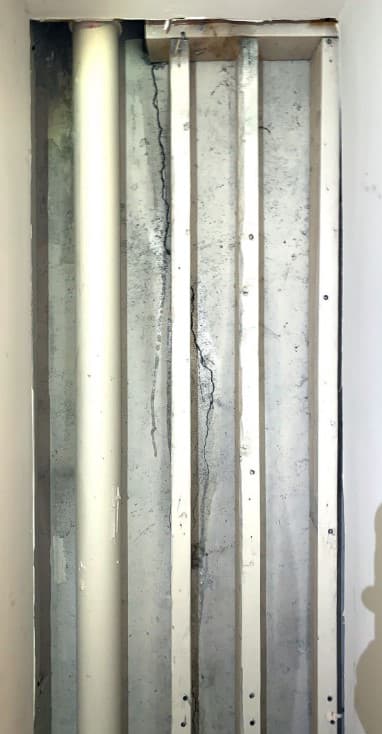
Originally posted 7/23/20, updated 12/15/22
Sometimes we find problems strictly by chance. Maybe you were weeding a flower bed and saw a crack in the foundation. Or you went to the basement to get your tennis racket out of storage, and discovered water trickling down the wall. Foundation cracks can happen anywhere, and for a variety of reasons. But one thing is for sure- they need to be fixed!
Acculevel is a family-owned and operated company that focuses on waterproofing and repairing foundations. We pride ourselves on being honest and transparent with our customers; we treat your home as if it were our own.
If the crack in your foundation is a symptom of a larger issue, we have the knowledge and experience to diagnose that for you. If the cracks in your foundation are relatively minor and the only repair you need? We’ll repair those for you- without suggesting unnecessary products or artificially inflating the costs.
We’ve been repairing foundation cracks since our start in 1996; over the years, we’ve tested a wide range of repair methods. Our customers get the best, longest-lasting results from the epoxy method that we’ve developed. We firmly believe this is the best repair method for cracks in concrete foundation.
In this article, we’ll explain how we decided on this method, how it works, and what it costs. I’ll also explain why it’s preferable over any DIY method you’ve heard of.
Why Do We Use Epoxy To Seal Cracks?
There are a variety of repair types available, and we’ve tested many of them. Other sealant materials failed our quality assurance tests. They either weren’t flexible enough to move with a foundation or they lacked the adhesive strength to stay in place.
Here in the Midwest, we experience a substantial temperature range between winter and summer; these fluctuations cause concrete to expand and contract. If a crack fill is too rigid, it won’t hold when the seasons change. And if it isn’t “sticky” enough to adhere thoroughly, it will come loose and allow the crack to widen and leak.
We’ve also tried the injection method, where small ports are pushed into the crack and used to inject the filler. But we found that epoxy applied this way did not adhere well enough, nor did the application process work efficiently. Using the port method prevents you from seeing exactly where the epoxy is, so you can’t be certain the area is adequately covered. We felt this left too much to chance- we wanted better results than the injector method provided. It’s also aesthetically unpleasant. The ports leave holes in the concrete, which seems to be counterproductive when you’re supposed to be repairing the wall.
We have enjoyed consistently good results from the epoxy fill method. We offer a 5 year warranty on crack repairs, and this method does the best job and causes the fewest issues for our customers. It can also be painted over with a standard interior paint, once it’s fully dried.
How to Repair Foundation Cracks with Epoxy
Interior Crack Repair
Most foundation cracks can be repaired from inside the basement or crawl space. An experienced contractor should be able to assess the crack and determine its primary cause: settling, water pressing against the foundation (hydrostatic pressure), or the seasonal changes we discussed earlier.
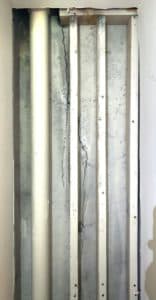 This photo was taken by an Acculevel project advisor during a routine appointment. The homeowner had noticed wet drywall in her basement, and called us for an assessment.
This photo was taken by an Acculevel project advisor during a routine appointment. The homeowner had noticed wet drywall in her basement, and called us for an assessment.
Our first step was to find the cracks and expose them. The water-damaged drywall had already been removed; our repair team needed to temporarily remove one of the two-by-fours in the wall.
 This photo was taken by an Acculevel crew member during repairs.
This photo was taken by an Acculevel crew member during repairs.
Once the cracks were exposed, we sanded the area to “rough up” the surface of the concrete. This gives the epoxy more surface area, and allows it to better adhere to the wall. The opening of the crack is also sanded at the surface, so the epoxy can be fully pressed into the crack itself.
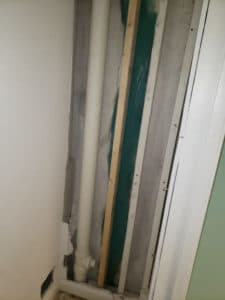 This photo was also taken by an Acculevel crew member after repairs were complete.
This photo was also taken by an Acculevel crew member after repairs were complete.
The epoxy is applied to the crack and to the surrounding edges of the crack, for approximately 2 inches in either direction. This improves adhesion, helps the epoxy in the crack hold to the wall, and creates a seal to repel water that may be trying to seep in through the crack.
Exterior Crack Repair
If the crack in your foundation is only visible from the inside of your home, an interior repair should be all that is required. But sometimes the crack is also visible from the outside- or it is only visible from the outside. In those instances, you need the exterior portion of the crack repaired as well.
The process for exterior crack repair has extra steps because it is exposed to the ground, changing weather conditions, and the elements at large.
The following photos were all taken by Acculevel crew members.
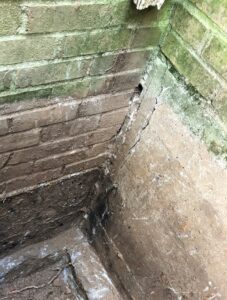
The crew begins repairs by excavating soil around the damaged foundation, until the entirety of the crack is exposed.

The epoxy portion of the repair is essentially the same, whether the crack is being treated from the inside or outside of the home. But the differences in repair methods start here. To help keep the repaired foundation dry and protected against the elements, we apply a substance called foundation mastic. This is an adhesive material designed for exterior use. The added layer of foundation mastic helps protect the epoxied crack and surrounding area, to extend the life of the repair.

As a final protective layer, a section of waterproofing material is applied on top of the mastic. This material is what we also use to encapsulate basements that are going to be finished; the encapsulation sheeting keeps any water that seeps through the wall from reaching the finishing pieces like insulation and drywall.
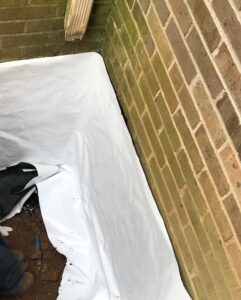
The mastic acts as an adhesive, to hold the waterproof liner in place. The soil that was removed during the excavation will be put back, filling the opening in the yard and concealing the repair materials from view.
Do You Need Both Types of Repair?
Sometimes, yes! If the crack penetrates all the way through the foundation, both interior and exterior crack repair is critical. Only repairing one side of the crack will leave the other side open to the conditions that caused the problem- and almost guarantees the crack will continue to expand.
Foundation Cracks: Repair Costs
Pricing is going to vary for this type of repair, since it depends on the number of cracks, the length, etc. In general, Acculevel has an $800 minimum on crack repair. The average repair cost breaks down to approximately $58 per linear foot.
DIY Foundation Crack Repair
I can understand why you might want to repair these foundation cracks on your own. It can be tempting to DIY a repair on something that seems so simple. After all, you can buy a good caulk gun for less than $40.
The problem with that reasoning is: your foundation is NOT a bathtub. In fact, none of the materials you can buy in a home improvement store are comparable to what a professional contractor uses. Please get an evaluation from a qualified professional any time you find an issue. Your foundation is not the place for DIY experimentation- if an issue at the foundation level is not properly addressed, it will get worse. Left alone or poorly remedied, it will actively cause damages throughout your home.
Additional Resources for You
Do you want more information about foundation repairs? This is our comprehensive guide that covers everything from causes to costs.
Is water getting into your basement through cracks in the foundation? Check out our Basement Waterproofing Guide.
Not sure how to hire the right contractor for you? We’ve compiled the Questions You Should Ask a Contractor, complete with a downloadable form for you to use.
Do You Have Cracks that Need Repair?
Please find an experienced and reputable contractor, and request an estimate. Most contractors will meet with you and evaluate your home at no cost to you. Make certain that you are given a written estimate, and confirm how long this estimate will be valid. (Acculevel estimates are good for 30 days.)
You should never sign a contract with any contractor without first verifying that they are well-rated and accredited with the Better Business Bureau. If you live in Indiana or the surrounding area, contact Acculevel. One of our experienced project advisors will evaluate your foundation and recommend the best whole-home solution for you, to keep your home strong and healthy for years to come.
